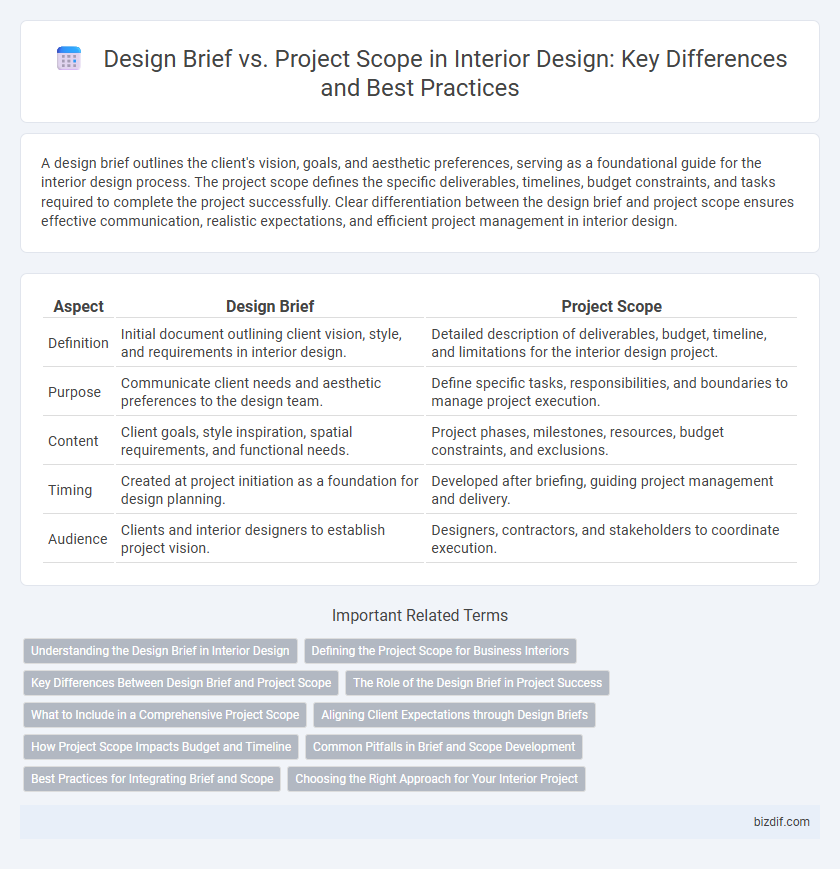A design brief outlines the client's vision, goals, and aesthetic preferences, serving as a foundational guide for the interior design process. The project scope defines the specific deliverables, timelines, budget constraints, and tasks required to complete the project successfully. Clear differentiation between the design brief and project scope ensures effective communication, realistic expectations, and efficient project management in interior design.
Table of Comparison
| Aspect | Design Brief | Project Scope |
|---|---|---|
| Definition | Initial document outlining client vision, style, and requirements in interior design. | Detailed description of deliverables, budget, timeline, and limitations for the interior design project. |
| Purpose | Communicate client needs and aesthetic preferences to the design team. | Define specific tasks, responsibilities, and boundaries to manage project execution. |
| Content | Client goals, style inspiration, spatial requirements, and functional needs. | Project phases, milestones, resources, budget constraints, and exclusions. |
| Timing | Created at project initiation as a foundation for design planning. | Developed after briefing, guiding project management and delivery. |
| Audience | Clients and interior designers to establish project vision. | Designers, contractors, and stakeholders to coordinate execution. |
Understanding the Design Brief in Interior Design
Understanding the design brief in interior design is essential for aligning client expectations with creative solutions by detailing project goals, desired aesthetics, functional requirements, and budget constraints. A clear design brief serves as a foundational document that guides spatial planning, material selection, and lighting design, ensuring cohesive and efficient project execution. Accurate interpretation of the design brief reduces revisions and enhances client satisfaction by providing a precise roadmap for designers and contractors.
Defining the Project Scope for Business Interiors
Defining the project scope for business interiors involves outlining specific deliverables, budget constraints, timelines, and spatial requirements to ensure alignment with client goals and operational needs. Clear project scope documentation minimizes scope creep by detailing functional zones, material specifications, and regulatory compliance for office layouts and commercial spaces. Accurate scope definition enhances communication among stakeholders and streamlines procurement, installation, and post-occupancy evaluation processes.
Key Differences Between Design Brief and Project Scope
The design brief outlines the client's vision, objectives, and aesthetic preferences, providing a creative framework for the interior design project. The project scope defines specific deliverables, timelines, budgets, and technical requirements, ensuring clear boundaries and manageability of tasks. Key differences include the design brief's emphasis on conceptual goals and style inspiration, while the project scope focuses on practical execution and resource allocation.
The Role of the Design Brief in Project Success
The design brief serves as a foundational document that outlines the client's vision, objectives, and requirements, guiding the entire interior design process with clarity and precision. It ensures alignment between designers and stakeholders by detailing essential elements such as style preferences, functional needs, budget constraints, and timeline expectations. A well-crafted design brief directly impacts project success by minimizing misunderstandings, streamlining decision-making, and enabling efficient resource allocation throughout the project lifecycle.
What to Include in a Comprehensive Project Scope
A comprehensive project scope in interior design must include detailed specifications of deliverables, precise timelines, budget constraints, and design objectives aligned with the client's vision. Clear definitions of spatial requirements, materials, finishes, and furniture selections ensure all parties understand the project's boundaries and expectations. Incorporating milestones, approval processes, and contingency plans minimizes risks and streamlines project execution from concept to completion.
Aligning Client Expectations through Design Briefs
Design briefs serve as essential tools for aligning client expectations by clearly outlining project goals, aesthetic preferences, and functional requirements, ensuring all stakeholders have a unified vision. Project scope defines the detailed boundaries, deliverables, and timelines, providing a structured framework to manage resources and prevent scope creep. Together, a well-crafted design brief and precise project scope facilitate seamless communication, enhance client satisfaction, and improve project outcomes in interior design.
How Project Scope Impacts Budget and Timeline
Project scope in interior design defines the full extent of work, including materials, labor, and specific deliverables, directly influencing budget allocation and scheduling. A well-detailed project scope minimizes costly changes and delays by setting clear expectations for contractors and clients. Accurate scope planning ensures efficient resource management, preventing budget overruns and timeline extensions.
Common Pitfalls in Brief and Scope Development
Common pitfalls in design brief and project scope development include vague objectives, unrealistic expectations, and insufficient stakeholder input, which can lead to misaligned design outcomes. Overlooking detailed requirements or failing to define clear deliverables often results in scope creep and budget overruns. Precise communication and thorough documentation are essential to avoid these challenges in interior design projects.
Best Practices for Integrating Brief and Scope
Integrating the design brief and project scope requires clear communication to ensure all client needs and project constraints align seamlessly. Best practices include detailed documentation of client expectations alongside a thorough analysis of deliverables, timelines, and budget parameters to avoid scope creep. Regular collaboration between designers, clients, and stakeholders fosters adaptability and ensures the interior design project adheres to both creative vision and practical limitations.
Choosing the Right Approach for Your Interior Project
Design brief and project scope serve distinct yet complementary roles in interior design projects; the design brief outlines client goals, style preferences, and functional needs, while the project scope details deliverables, timelines, budget, and specific tasks. Selecting the appropriate approach hinges on clarity and alignment: a well-defined design brief fosters creativity and client-designer collaboration, whereas a comprehensive project scope ensures project management efficiency and accountability. Prioritizing both elements optimizes communication, minimizes risks, and drives successful interior design outcomes tailored to client expectations.
Design Brief vs Project Scope Infographic

 bizdif.com
bizdif.com